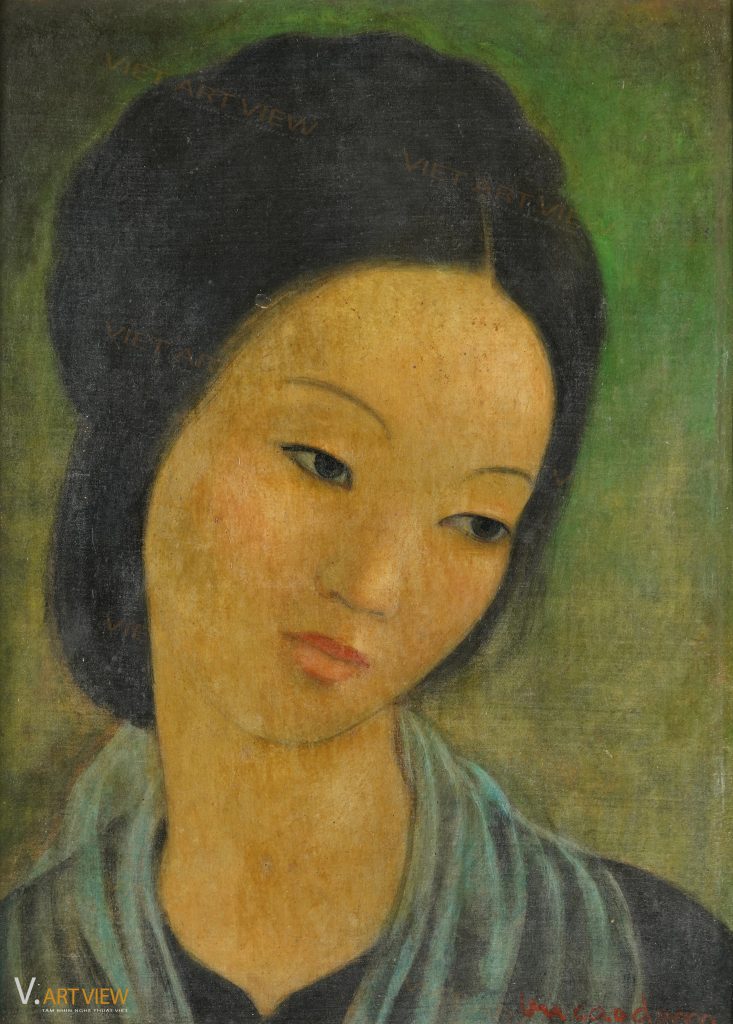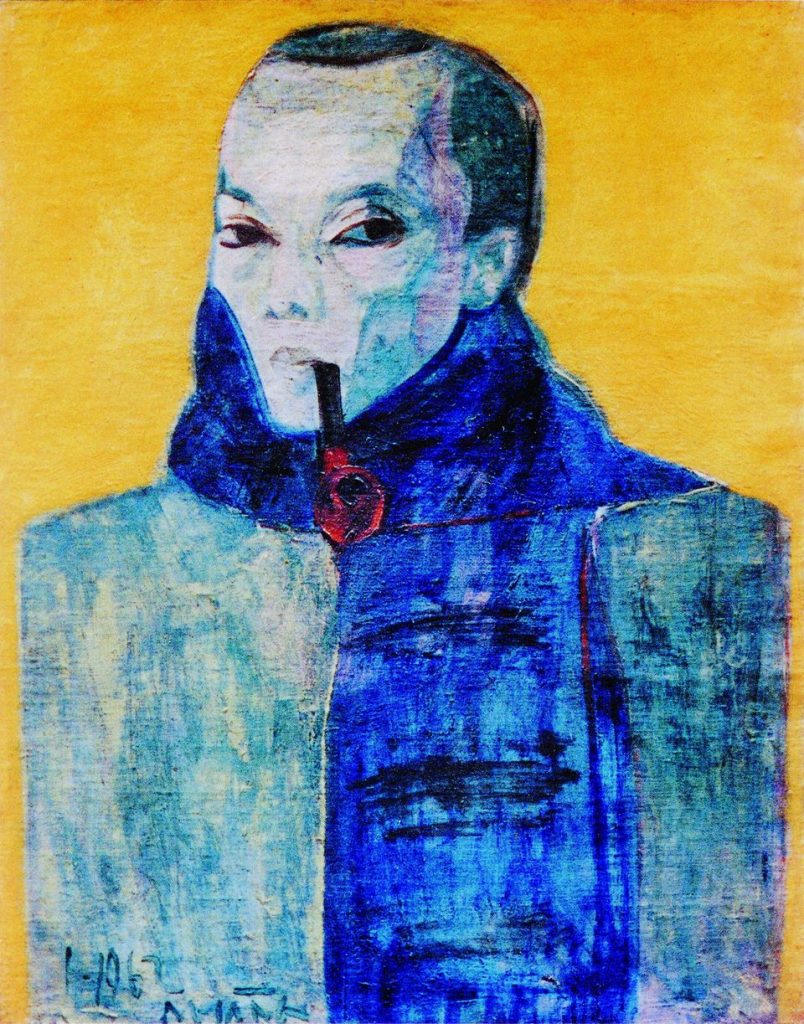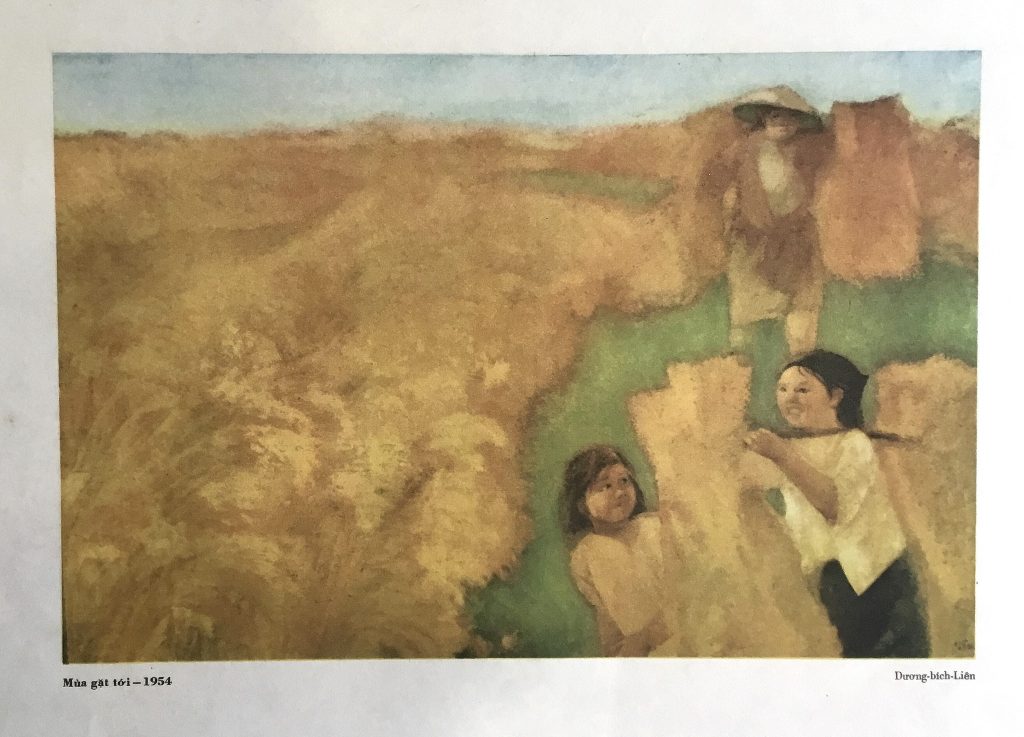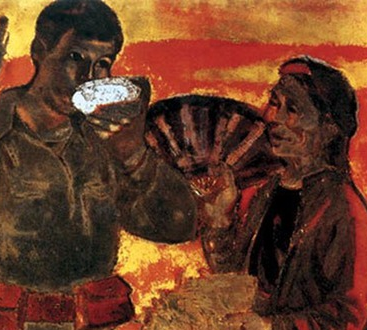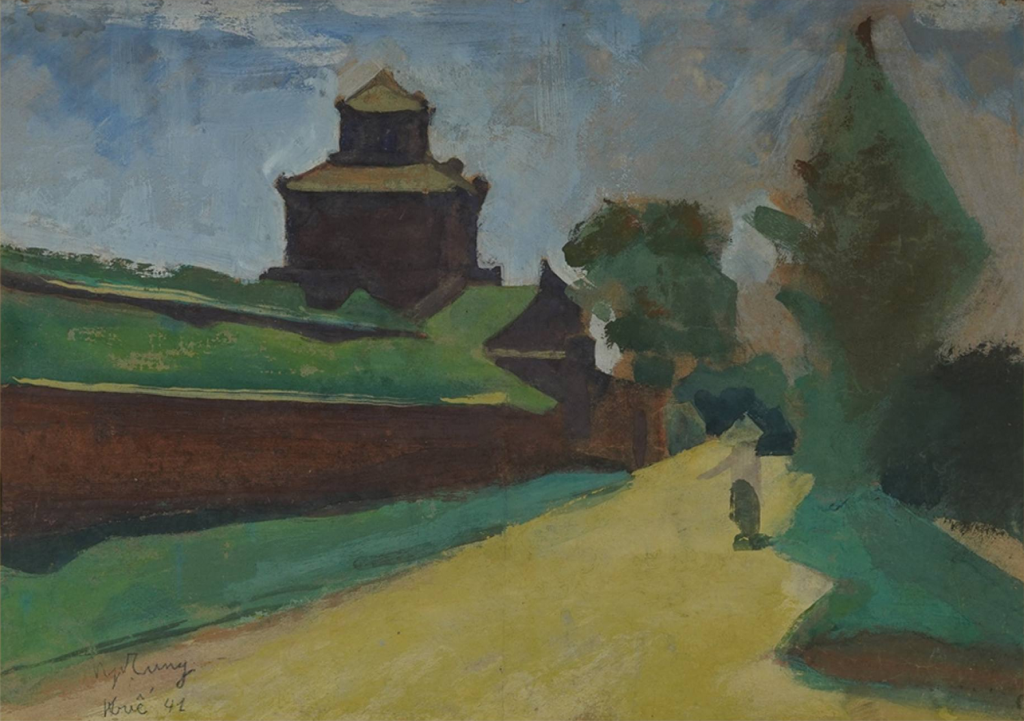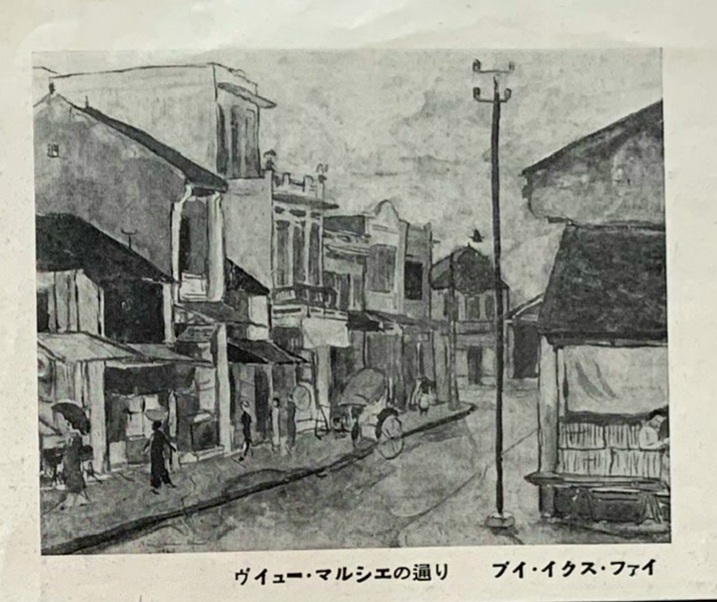Like many painters in the North, painter Nguyen Huyen has many paintings on the subject of portraits and daily life of ethnic minorities in mountainous areas. In which, Mai Chau, Hoa Binh is the place chosen by many artists to stop to paint because of its beautiful location and charming scenery. Equally important is that Hoa Binh is not too far from Hanoi, convenient for traveling.
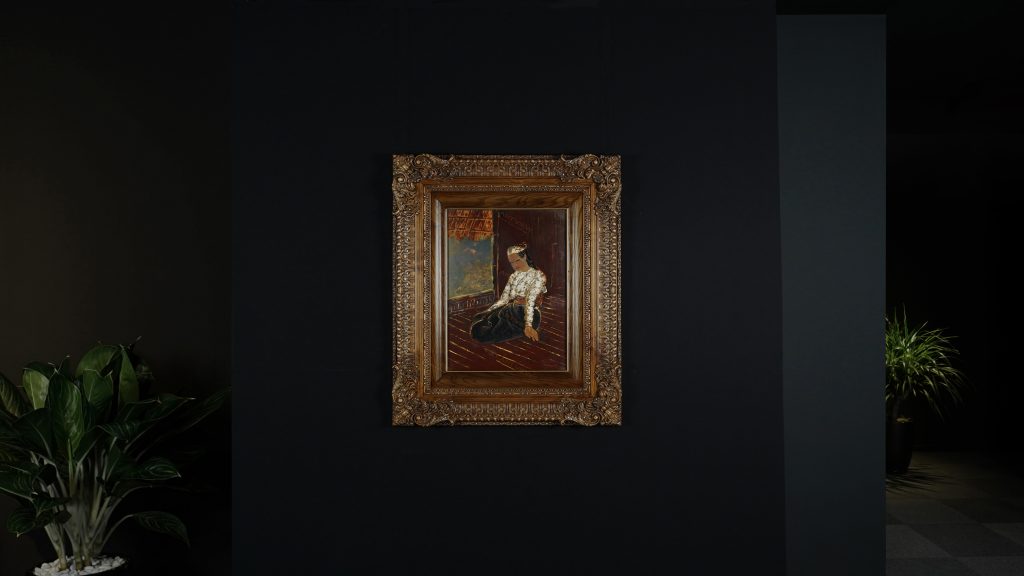
Nguyen Huyen (1915 – 1994). A Young Woman of Muong in Mai Chau. 1970. Lacquer. 60×45 cm
Lacquer painting ‘A young woman of Muong in Mai Chau’ was displayed in 2018, in Hanoi, the exhibition titled ‘Nguyen Huyen Painting’. The exhibition included more than 50 works, mainly lacquer medium; then oil, pastel, watercolor.
In the exhibition ‘Nguyen Huyen Painting’, this painting was initially called ‘Waiting Corner’. But when making this video, Viet Art View took the liberty of changing the name to a clear and simple name, suitable for the content. The painting ‘A young woman of Muong in Mai Chau’ was built on the basis of a watercolor sketch. On the left hand side below of the watercolor, it is clearly written “Huyến, Mai Châu, 61, 21, X” (Nguyen Huyen, Mai Chau, October 21, 1961).
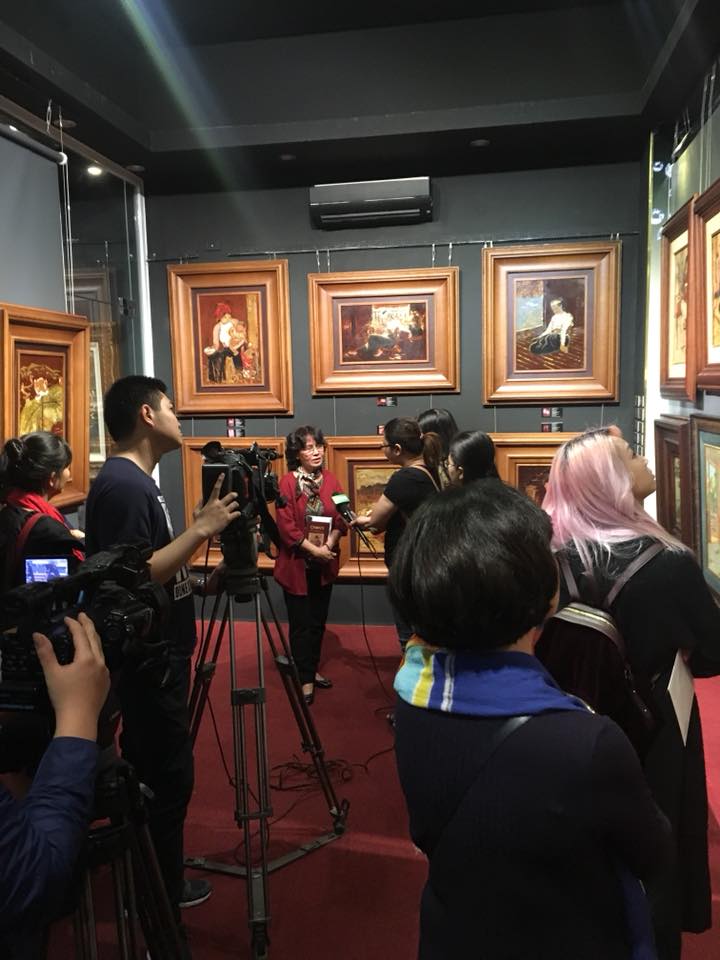
The exhibition ‘Nguyen Huyen painting’
Thus, until 1970, nine years after the watercolor sketch in Mai Chau, Hoa Binh, ‘A young woman of Muong in Mai Chau’ had just been completed by Nguyen Huyen with lacquer medium. This was completely consistent with the conditions at that time. Because in the past, cameras were very rare and traffic was not convenient. Artists when going to the battlefield, going to local practice or places with beautiful scenery often sketched with pencil, ballpoint pen, pen, and watercolor. Sometimes painting right in reality with gouache, oil. Materials that require more time such as lacquer and silk were often created later.
Nguyen Huyen is a painter with a rather special visual language. He not only used strokes to create “the perimeter of one or more shapes, or object with a different shape” in a space, but he also used strokes to create sensation. He liked to use curving, twisting, interlacing strokes, a combination of strokes, creating muscle movement. For shaping the male character is billowing of the shape.
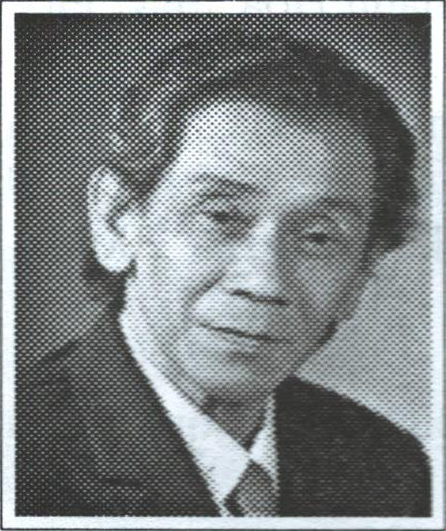
Portrait of artist Nguyen Huyen (1915- 1994)
This visual style reminds viewers of the shapes in the works of French painter – Eugène Delacroix (1798-1863). He is a world-famous painter of the 19th century, his name was famous with the painting ‘Goddess of Liberty leading the people’, created in 1830. We put the painting ‘Hunting lion’, by Deacroix, created in 1861 to see the twists and curves that perhaps Nguyen Huyen had been influenced in his shaping.
The twists and curves seem to be only found in Nguyen Huyen’s paintings, but even in the 100d blue buffalo note, created by him in 1946, the character was also created in an expressive language. The lines, strokes and shapes characteristic of Nguyen Huyen’s painting language create beautiful images, the movement is firm and steady, just as required for the “simple, idyllic, realistic image of the farmer”. Minister of Finance at that time, Le Van Hien, once shared: “You draw banknotes like painting. That is also the reason why Vietnamese banknotes are beautiful.”
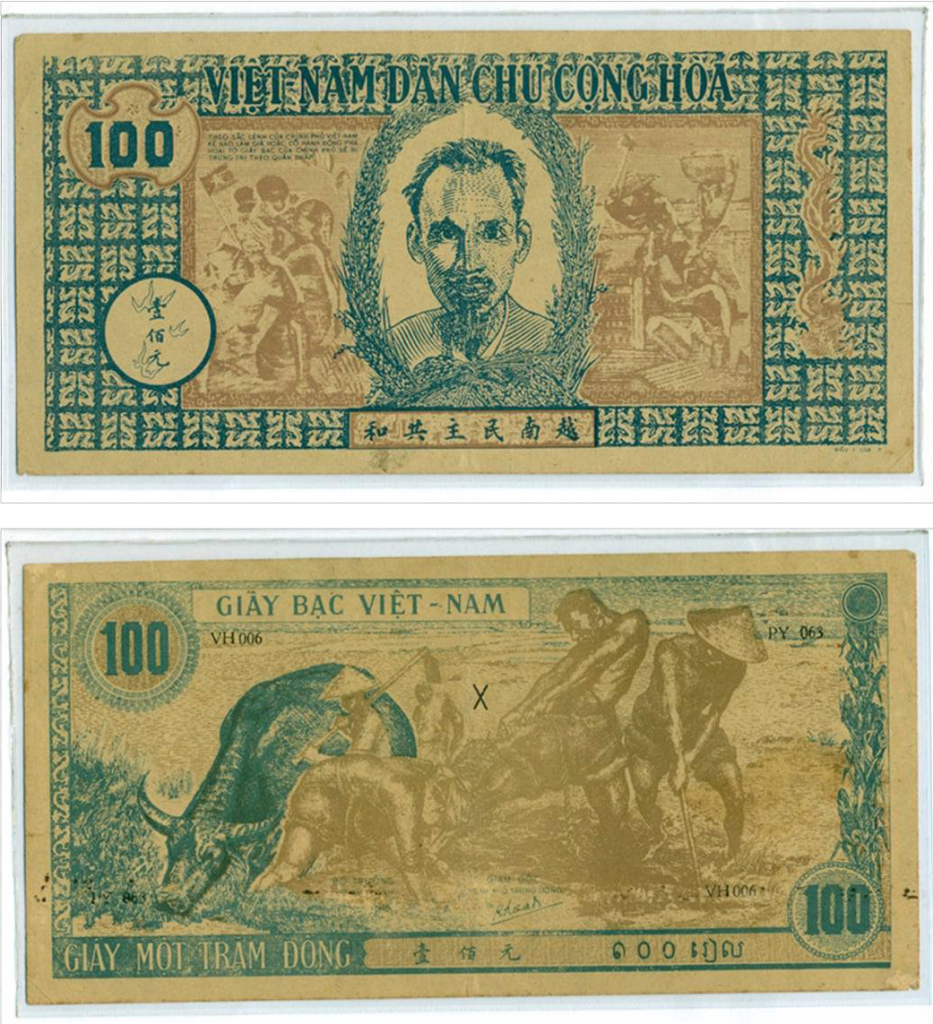
The 100d blue buffalo note, designed by Nguyen Huyen in 1946
For woman characters, he used strokes to cover the circumference of the woman figure but had been visualized as “push up” compared to reality. The curves are sometimes “exaggerated” but are very sympathetic to the sweet, feminine beauty. Nguyen Huyen has a special talent in regulating the rhythm of strokes with the obvious stability of his virtuosic academic painting skills. His shapes are rhythmic, flexible, creating a sense of the movement of the body…
Around the 1960s, painter Nguyen Huyen had a field trip to Mai Chau, Hoa Binh. With a rich source of sketch material on a variety of topics, he used that saved vivid realistic image in later paintings of lacquer, silk, oil… Nguyen Huyen is an artist who loves beautiful moments. He portrayed the image of a young Muong ethnic girl in Mai Chau in many rich activities such as in stilt house, by the fire, spinning, weaving… very charming and feminine. These paintings all evoke beautiful emotions about flexible shapes, soft contours. Lacquer material with deep colors of the basic black, vermilion, and mother of pearl white palette was still very technically used by Nguyen Huyen, skillfully, reasonably with bold, light, large and small strokes, dividing the shapes according to the lines that describe figure, clothes, things.
The painting ‘A young woman of Muong in Mai Chau’ is not outside of the typical basic character shaping system of Nguyen Huyen. We see again the roundness of the shape, the contours that he used the tip of a brush to create a dark and light border with gold leaves. The areas that needed light, he sanded down more, but not according to a specific level of light, some areas are lighter then some areas are darker. For the color patches need to be sanded, he used the impulse of his hand to create shapes on surface of the painting. He did not use brush strokes to make light and dark, but used a color and then sanded it lightly or hard to create light and dark.

Nguyen Huyen (1915 – 1994). A Young Woman of Muong in Mai Chau. 1970. Lacquer. 60×45 cm
In ‘A young woman of Muong in Mai Chau’, in addition to eggshells to create white, painter Nguyen Huyen also used mother of pearl. The layer of mother-of-pearl sparkling blue was often used by him in a few details such as creating highlight of quality. The mother-of-pearl point is one of Nguyen Huyen’s differences compared to other lacquer painters. Creating a tight, round shape, smooth and rhythmic strokes on the basis of a firm and drastic style are typical, unique points in Nguyen Huyen’s painting language.
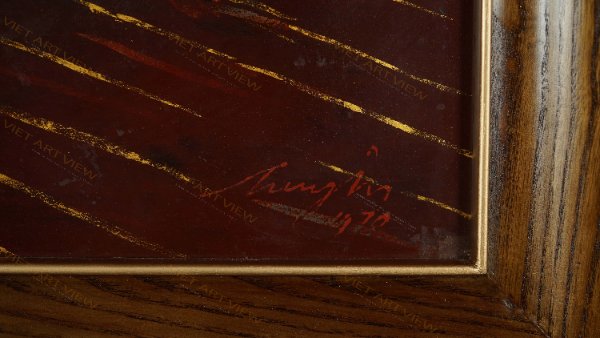
There is an opinion that Nguyen Huyen’s paintings are more decorative than the language of painting… or he painted one subject for many different paintings. In fact, many Vietnamese painters (in the past) painted over and over again the same picture. Especially painters with lacquer workshops. But with Nguyen Huyen, the same topic “fishes and hornworts” or “lotus” he painted no work like the other. Each painting is a separate image (forms, things) on the basis of style, visual language that just by looking at the painting, one can immediately know “this is artist Nguyen Huyen’s painting”.
In the legacy of massive works with hundreds of paintings of lacquer, oil, silk, pastel, if we want to understand Nguyen Huyen’s paintings, it’s not difficult. Just have a (relative) work image system we will see the distinctive features of “Nguyen Huyen painting”; his continuous and persistent creative labor is very appreciated…
***
Biography of painter Nguyen Huyen (Nguyen Duc Huyen)
- Born: May 2, 1915 in Hanoi
- Died: July 12, 1994 in Hanoi
- Origin: Tu The Village, Tri Qua Commune, Thuan Thanh District, Bac Ninh Province
- The Kinh
- Graduated from: Indochina Fine Arts College 1932-1936
- SADEAI Prize 1937
- In 1939, 1941, 1942 joined exhibitions in France
- 1941, 1943 group exhibition in Hanoi
- In 1950, a solo exhibition at the Representative Office of the General Director of Information, Hang Trong Street
- 1951 exhibition at Hanoi Opera House
- Founding member of Vietnam Fine Arts Association
- Member of branch of Painting
- Year of joining the Association: 1957
Major works:
- ‘Ha Long Bay’. 1977. Lacquer. 150×400cm;
- ‘A peaceful village’. 1982. Lacquer. 122×234cm;
- ‘Back to field’. 1974. Lacquer. 112×240cm;
- ‘One Pillar Pagoda’. 1960. Embossed lacquer. 108×122cm;
- ‘Lotus’. 1985. Lacquer. 57×59cm;
- ‘Roosters crow in the morning’. 1979. Lacquer. 75×110cm;
- ‘Family of fishing boat’. 1986. Silk. 86×140cm.
Award:
- Medal for the cause of Vietnam Fine Arts
Bài viết bởi Viet Art View
Bản quyền thuộc về Viet Art View


